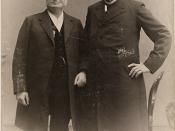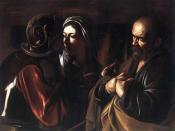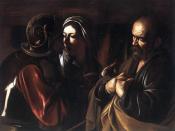The elements most abundant in this piece are that of color, light and shadow, and space. These are the primary elements most apparent, though other elements are present in the painting as well. This particular piece is not so concerned with incorporating background into telling the story, as it is blurred and somewhat distorted. The concentration of the piece is directed to the figures presented in the painting and the story being depicted.
The use of light and shadow are what catches the viewer's eye first as the face of St. Peter and the woman are illuminated by what is said to be a fireplace in the background, though not in view. This effect gives the idea that these are the two most important figures in the painting and the story revolves around these two figures. The figure of the soldier seems to be relatively less important due to the fact that the apparent fireplace only illuminates the back of the armor of which he is wearing.
The detail of the soldier's face is hidden in his own shadow and is only outlined by the reflective light from the face of the woman, further demonstrating his importance. The light aids in the telling of the story as one can see that the woman's eyes are facing the soldier while she points at St. Peter indicating that she is telling the soldier of St. Peter's misdoings. The light works to show the expression on St. Peter's face, as he appears to be defending himself against the accusation being made.
The use of color establishes the mood and represents the figures character. Collectively, the colors used are dark, seemingly representing mild silence or discreteness, or melancholy. This use of dark colors surrounds the three characters and incorporates the aforementioned emotions into the...


